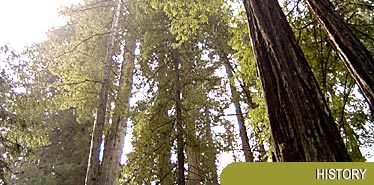| Stewards is a nonprofit environmental organization that works
in cooperation with the California Department of Parks and Recreation in the Russian
River Sector to provide the public with opportunities for personal inspiration,
satisfaction, and nurturing of spirit and intellect through environmental stewardship
programs. |
|
In 1860 R. B. Lunsford established a lumber camp on the north
bank of the Russian River which grew with success and was later known as "Stumptown".
In 1867 a 25 year old Swiss immigrant arrived in Stumptown. His name was George
E. Guerne. Guerne purchased land in the area and laid out a subdivision which
became known as "Guernewood Park"'. Guerne also built and operated a
sawmill in Stumptown. Before long, Stumptown was renamed for its most important
resident and has been known ever since as Guerneville.
In 1867 Thomas H. Stone and A. E. Laud established claims on 240 acres of valley
property 3 miles north of Guerneville. These 240 acres are the heart of what is
now Armstrong Redwoods State Reserve. This property and 200 adjoining acres were
eventually consolidated under the ownership of one person in 1875. This owner
was Colonel James Boydston Armstrong.
Armstrong was born on August 29, 1824 in Waynesburg, Ohio. His career had included
journalism and surveying in his native state and elsewhere. During the Civil War,
Armstrong had been commissioned a Colonel in the Union Army - a title he would
be known by ever after. In 1874 Armstrong relocated permanently to Sonoma County
from Ohio. Armstrong's business ventures were many, and one of them involved him
in the Guerneville lumber boom of the 1870's. Armstrong logged and also owned
and operated a sawmill sited north of Guerneville. This mill produced approximately
5 million board feet of lumber per year. Other of his business interests included
subdivisions in Santa Rosa. He sold lots to homebuilders at bargain prices and
encouraged the new owners to plant French prune and Gravenstein apple trees. Armstrong
was keenly interested in crop plants and experimented on different species in
nurseries he established in the Santa Rosa area. His interest in this field led
to his friendship with another Santa Rosan, Luther Burbank.
In 1878 Armstrong made a gift deed of the 440 acres mentioned earlier to his daughter,
Kate Armstrong. The price recorded for this transaction was "In consideration
of one dollar, love and affection". It had been Armstrong's intention for
this property - an old growth redwood grove - to be preserved and eventually be
operated as an arboretum. The Colonel worked long and hard at assuring the preservation
of the grove and in 1891 attempted to establish an administration for it patterned
after Stanford University's, with Luther Burbank as the chairman of its first
committee. Unfortunately, Armstrong was unable to realize his plan as it required
a special act of the State legislature and such support did not exist at the time.
Despite this defeat, Armstrong continued to work and plan toward the realization
of his dream - the preservation of his beloved grove of redwoods.
Armstrong suffered serious financial distress due to the failure of a Santa Rosa
bank. His daughter Kate was a life long invalid and her health went into a further
decline as did his own. As a consequence of family pressure, 190 of Kate's 440
acres was deeded to her brother, Walter. This parcel was later purchased by Armstrong
family friend, Harrison M. LeBaron. (Yes - the same family.) Kate Armstrong died
in 1898 and the Colonel passed on in 1900 after a series of incapacitating strokes.
The struggle to preserve the grove was left in the capable hands of Lizzie Armstrong
Jones - Armstrong's surviving daughter -and the LeBaron family. These people mounted
an energetic campaign which used public meetings, rallies, and car-caravans to
direct public attention to the need to preserve this last remnant of the once
mighty redwood forest.
Their efforts were finally successful and in 1917 the County of Sonoma passed
an initiative to purchase the property for $80,000.00. This purchase was contingent
on an agreement that Lizzie and the LeBaron family each put up $5,000.00 of the
purchase price as a donation - no empty gesture when you consider what value a
1917 dollar had against today's.
The grove was operated by Sonoma County until 1934 when the State took ownership
of it as part of the financial arrangement whereby Sonoma Coast State Park was
purchased. The grove was opened to the public as Armstrong Redwoods State Park
in 1936. In 1964 the grove's status was changed when a greater understanding of
its ecological significance prompted a more protective management of the resource.
Since 1964 Armstrong Redwoods has enjoyed the status of State Reserve.
The story of Armstrong's grove continues - it is dynamic as are all living entities.
But most of all it is the people who use it, enjoy it, manage and protect it who
affect it the most. Recent changes and resulting conflict centered around different
perceptions, may be felt by the persons involved as either minor asides or major
issues in the scope of their lifetimes. In the much grander panorama of the grove's
lifetime, human actions may have long range consequences unknowable to short-lived
individual human beings. It is therefore only right that people of integrity and
good will speak for the grove, for she can only talk to our hearts.
As Smokey once said, "Thanks for listening!"
As the unit historian I am indebted to many sources for the material set down
in this and other records, but most of all to Historian John McKenzie's work. |
|



